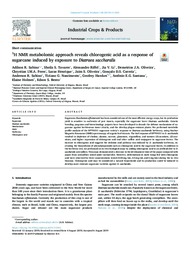1H NMR metabolomic approach reveals chlorogenic acid as a response ofsugarcane induced by exposure toDiatraea saccharalis.
1H NMR metabolomic approach reveals chlorogenic acid as a response ofsugarcane induced by exposure toDiatraea saccharalis.
Autoria: SABINO, A. R.; TAVARES, S. S.; RIFFEL, A.; LI, J. V.; OLIVEIRA, D. J. A.; FERES, C. I. M. A.; HENRIQUE, L.; OLIVEIRA, J. S.; CORREIA, G. D. S.; SABINO, A. R.; NASCIMENTO, T. G.; HAWKES, G.; SANTANA, A. E. G.; HOLMES, E.; BENDO, E. S.
Resumo: Sugarcane(Saccharum officinarum)has been considered one of the most efficient energy crops, but its productionyield is sensitive to outbreaks of pest insects, especially the sugarcane borerDiatraea saccharalis. Geneticbreeding programs and biotechnology projects have been developed to decode the defense mechanisms of su-garcane against herbivorous insect attacks, and the develop plague-resistant plants. We performed metabolicprofile analysis of the SP791011 sugarcane variety?s response toDiatraea saccharalisherbivory, using NuclearMagnetic Resonance (NMR) spectroscopy of organic leaf extracts. The leaf response of SP791011 toD. saccharalisresulted in depletion of choline, alanine, sucrose, glutamate, trigonelline, and isomers (E)-aconitate, (Z)-aco-nitate, and higher expression of chlorogenic acid and other caffeic acid conjugates in sugarcane leaves. Theincrease in chlorogenic acid suggests the shikimic acid pathway was induced byD. saccharalisherbivory, in-creasing the biosynthesis of phenylpropanoids such as chlorogenic acid in the sugarcane leaves. In addition tothe herbivory test, we performed an in vivo biological assay by adding chlorogenic acid to an artificial diet toD.saccharaliscaterpillars. This assay demonstrated a decrease in the development time of the pupae compared withpupae from caterpillars raised under normal diet. However, deformations in moth wings fed with chlorogenicacid were observed for three concentrations tested (0.05 mg/mL, 0.5 mg/mL and 5 mg/mL) during the in vivobioassay. Chlorogenic acid may be considered a natural biopesticide and its production could be induced todevelop more resistant sugarcane varieties againstD. saccharalis.
Ano de publicação: 2019
Tipo de publicação: Artigo de periódico
Unidade: Embrapa Tabuleiros Costeiros
Palavras-chave: Cana de Açúcar, Inseto, Inseto Para Controle Biológico, Sugarcane
Observações
1 - Por padrão são exibidas publicações dos últimos 20 anos. Para encontrar publicações mais antigas, configure o filtro ano de publicação, colocando o ano a partir do qual você deseja encontrar publicações. O filtro está na coluna da esquerda na busca acima.
2 - Para ler algumas publicações da Embrapa (apenas as que estão em formato ePub), é necessário ter, no celular ou computador, um desses softwares gratuitos. Sistemas Android: Google Play Livros; IOS: iBooks; Windows e Linux: software Calibre.
Acesse outras publicações
Acesse a Base de Dados da Pesquisa Agropecuária (BDPA) para consultar o acervo completo das bibliotecas da Embrapa.

